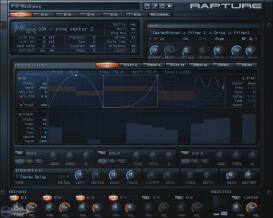View other reviews for this product:
« Extremely deep synth! »
Published on 10/22/14 at 15:02Installing Rapture is a snap with no extra license manager applications to install. That said, the interface can be a bit overwhelming to someone first loading it. There's a page for each oscillator and each envelope for those oscillators which means making your own patches will require lots of flipping back and forth between the oscillator and envelope pages until you're done tweaking. There are also lots of small text options on the interface for adjusting things like detune, velocity tracking, etc. It's not the most straight-forward interface, but the manual does describe all of the interface functions succinctly.
SUITABILITY/PERFORMANCE
I've been using Rapture in production for about 4 months with no instability in REAPER, however Rapture seemed to have a bit of incompatibility with Renoise 3.0. Rapture would randomly spike CPU up to 100% and stay there, shutting down the audio engine and forcing you to restart Renoise for it to behave properly. Performance in REAPER is very respectable, though--Using a similar patch in Rapture, CPU use was roughly equivalent to Massive and Ultra Analog, about 3% CPU for a large pad sound.
OVERALL OPINION
Rapture is a wavetable synthesizer, which uses any one of over 200 sound files to use as the source for the oscillators and you can load in your own .wav files to use as waveforms as well. This opens up some very interesting sound design capabilities as you can load sounds besides standard analog waveforms to use for synthesis.
The presets showcase the sonic capabilities of the synth, however, Rapture has been around for several years and most of the presets sound quite dated for modern productions.
A major feature that sets Rapture apart from a lot of synthesizers are the envelopes. Gone are the traditional ADSR controls, replaced instead with the ability to draw your own envelopes using custom curves. You can make very complex shapes and get incredibly animated modulation. There's also a step sequencer to use with your envelopes for more rhythmic movement. For further sound sculpting, you can use up to 2 of the 19 filters and add built-in insert effects such as reverb, delay, and distortion per oscillator as well as use those globally across all of the 6 oscillators.
If you can get past the fairly cumbersome interface and dig into the possibilities that the multistage envelopes and wavetable synthesis can provide, you'll find yourself able to make huge, lush pads and insanely animated basses and leads. However, If you're mostly a preset player or aren't interested in complex sound design this may not be the synth for you.
Pros:
+ Capable of very complex modulation with the multistage envelopes
+ Many filter types and insert effects
+ Effects, filters, and envelopes are independent for each oscillator
Cons:
- Interface is overwhelming at first glance and fiddly. Lots of very small text and pages.
- Presets are dated
SUITABILITY/PERFORMANCE
I've been using Rapture in production for about 4 months with no instability in REAPER, however Rapture seemed to have a bit of incompatibility with Renoise 3.0. Rapture would randomly spike CPU up to 100% and stay there, shutting down the audio engine and forcing you to restart Renoise for it to behave properly. Performance in REAPER is very respectable, though--Using a similar patch in Rapture, CPU use was roughly equivalent to Massive and Ultra Analog, about 3% CPU for a large pad sound.
OVERALL OPINION
Rapture is a wavetable synthesizer, which uses any one of over 200 sound files to use as the source for the oscillators and you can load in your own .wav files to use as waveforms as well. This opens up some very interesting sound design capabilities as you can load sounds besides standard analog waveforms to use for synthesis.
The presets showcase the sonic capabilities of the synth, however, Rapture has been around for several years and most of the presets sound quite dated for modern productions.
A major feature that sets Rapture apart from a lot of synthesizers are the envelopes. Gone are the traditional ADSR controls, replaced instead with the ability to draw your own envelopes using custom curves. You can make very complex shapes and get incredibly animated modulation. There's also a step sequencer to use with your envelopes for more rhythmic movement. For further sound sculpting, you can use up to 2 of the 19 filters and add built-in insert effects such as reverb, delay, and distortion per oscillator as well as use those globally across all of the 6 oscillators.
If you can get past the fairly cumbersome interface and dig into the possibilities that the multistage envelopes and wavetable synthesis can provide, you'll find yourself able to make huge, lush pads and insanely animated basses and leads. However, If you're mostly a preset player or aren't interested in complex sound design this may not be the synth for you.
Pros:
+ Capable of very complex modulation with the multistage envelopes
+ Many filter types and insert effects
+ Effects, filters, and envelopes are independent for each oscillator
Cons:
- Interface is overwhelming at first glance and fiddly. Lots of very small text and pages.
- Presets are dated



